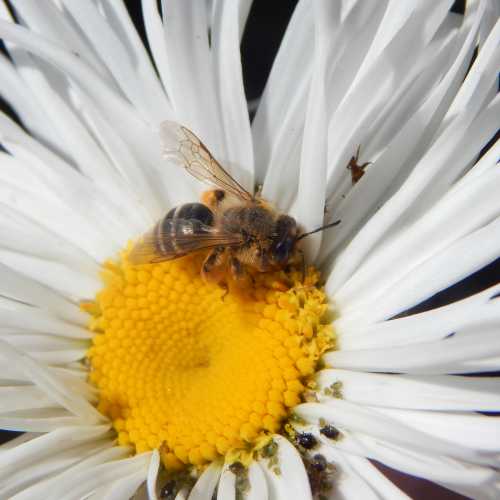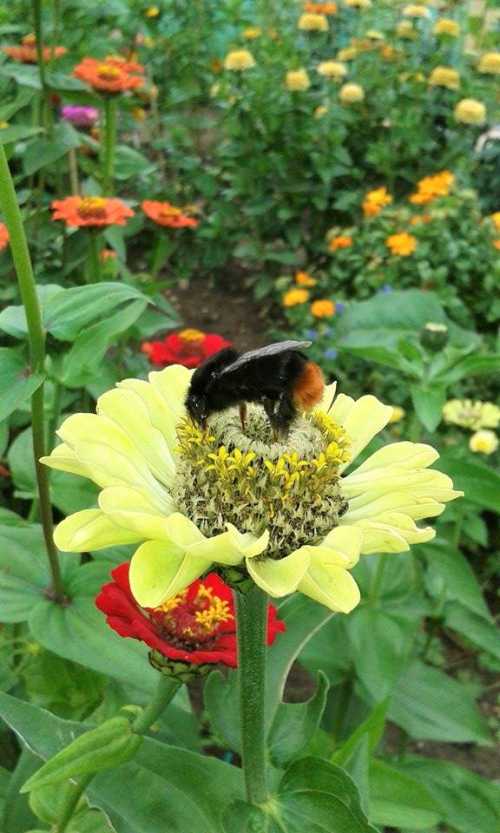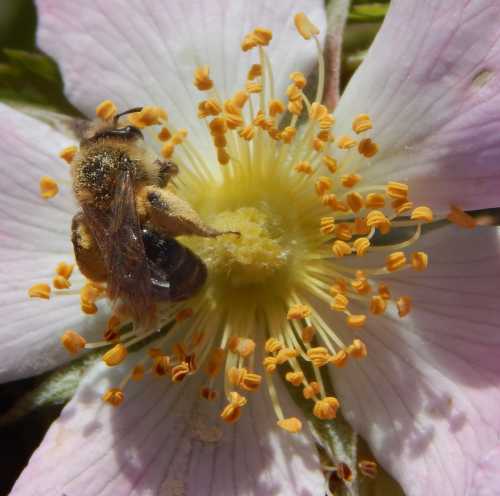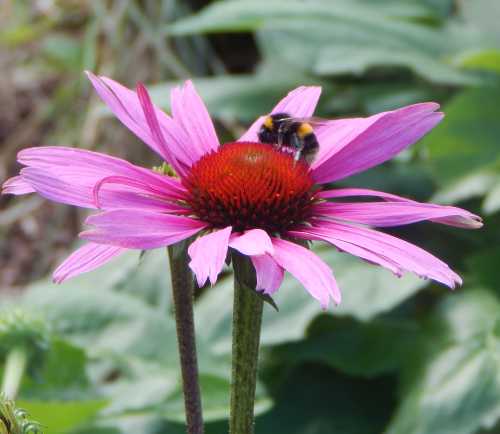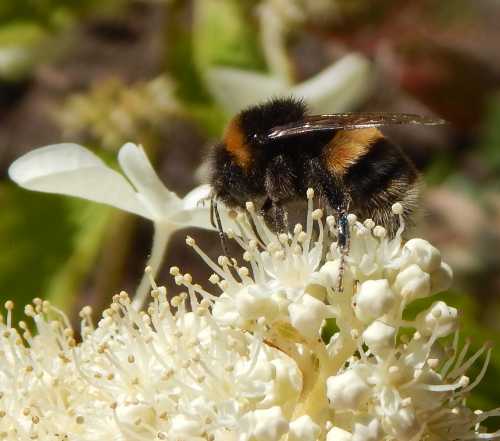Do Bees Like Marigolds?
In my experience, bees certainly like some species of marigold, and seem less interested in others.
Partly, it depends on what you term as a 'marigold' (some people think instantly of pot marigolds, others think of French marigold), so here we'll take a look at which marigolds you should include in your garden if you want to attract bees.
Best marigolds for bees
From the evidence I have seen:
- pot marigold - Calendula officinalis, and
- corn marigold - Glebionis segetum
are attractive to bees. Both belong to the Asteracaea family, along with many other flowers popular with bees and pollinators, including oxeye daisies, and others with lovely open, saucer shaped blooms, as Cosmos bipinnatus.
.
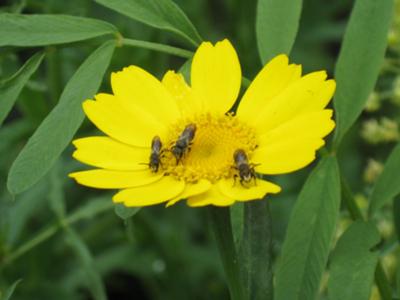 Heriades truncorum - large-headed resin bees on corn marigold. (Image submitted by Marco, Netherlands)
Heriades truncorum - large-headed resin bees on corn marigold. (Image submitted by Marco, Netherlands)Not only that, these particular marigolds have scientific data which records their tremendous value for bees.
A study in 20161 examined the nectar and pollen reward for a range of plants, including a comparison of flowers from a commercial annual flower mix.
Calendula officinalis - pot marigold or English marigold, was listed among the flowers, and on a separate list, the corn marigold, Glebionis segetum was also analyzed, but I have added it to the list below.
As you can see from the data, the corn marigold scores highest in the group in its provision of nectar reward for bees.
Additionally, corn marigold has a good level of longevity, meaning it provides more days of foraging opportunity for bees and other pollinators. If you are happy to include this lovely wildflower in your garden, you'll probably appreciate this longer-flowering characteristic.
You might also attract Heriades truncorum - the large-headed resin bee, as pictured above!
Nevertheless, the pot marigold comes in at a respectable fourth in the list.
| Common name | Scientific name | Mean mass of nectar sugar per flower (µg/day)* | Floral unit longevity (days) |
|---|---|---|---|
| Corn-marigold | Glebionis segetum | 931.210 | 8.333 |
| Cornflower | Centaurea cyanus | 895.831 | 6.467 |
| Cosmos | Cosmos bipinnatus | 701.078 | 8.154 |
| Pot Marigold | Calendula officinalis | 469.515 | 6.706 |
| Showy Baby’s breath | Gypsophila elegans | 369.234 | 2.357 |
| Tickseed | Coreopsis picta | 277.902 | 13.200 |
| Love-in-a-mist | Nigella damascena | 240.301 | 5.789 |
| Golden Tickseed | Coreopsis tinctoria | 133.471 | 5.067 |
| Red Flax | Linum grandiflorum | 50.214 | 1.864 |
| Virginia Stock | Malcolmia maritima | 46.349 | 4.280 |
| Californian Poppy | Eschscholzia californica | 10.317 | 3.440 |
| Sweet Alyssum | Lobularia maritima | 4.213 | 2.631 |
| Common poppy | Papaver rhoeas | 0.570 | 2.239 |
*Mean mass of nectar sugar per single flower or capitulum (µg/day)
In comparing pollen reward, you can see that pot marigold offers plenty of pollen and just behind the poppies, this time with the corn marigold a few places below.
| Common name | Scientific name | Mean volume of pollen (µl/day)* | Floral unit longevity (days) |
|---|---|---|---|
| Common poppy | Papaver rhoeas | 5.958 | 2.239 |
| Californian Poppy | Eschscholzia californica | 2.407 | 3.440 |
| Pot Marigold | Calendula officinalis | 1.814 | 6.706 |
| Cosmos | Cosmos bipinnatus | 1.692 | 8.154 |
| Red Flax | Linum grandiflorum | 0.707 | 1.864 |
| Corn-marigold | Glebionis segetum | 0.609 | 8.333 |
| Love-in-a-mist | Nigella damascena | 0.549 | 5.789 |
| Cornflower | Centaurea cyanus | 0.547 | 6.467 |
| Golden Tickseed | Coreopsis tinctoria | 0.455 | 5.067 |
| Showy Baby’s breath | Gypsophila elegans | 0.072 | 2.357 |
| Virginia Stock | Malcolmia maritima | 0.057 | 4.280 |
| Tickseed | Coreopsis picta | 0.055 | 13.200 |
| Sweet Alyssum | Lobularia maritima | 0.006 | 2.631 |
*Mean volume of pollen per flower or capitulum per day (µl/day)
In conclusion, both pot marigold and corn marigold are excellent flowers for bees and pollinators, and would make a useful addition to the bee garden.
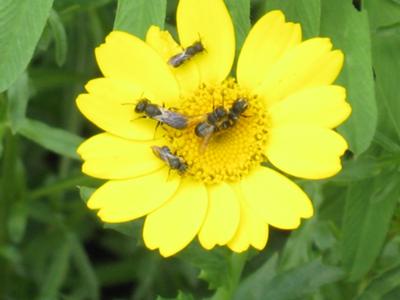 Heriades truncorum (large-headed resin bees) on corn marigold. (Image submitted by Marco, Netherlands)
Heriades truncorum (large-headed resin bees) on corn marigold. (Image submitted by Marco, Netherlands)Growing Marigolds For Bees
If you'd like to grow Calendula officinalis, you could try the following varieties which are known to attract bees (shades are warm oranges and yellows):
- 'Indian Prince'
- 'Daisy May'
- 'Snow Princess'
- 'Apricot Pygmy'
Pot marigolds are easy to grow, and are fairly tolerant of a range of soils, but do ensure they have sunshine. Simply sow them where they are to flower.
Additional tip: I recall reading advice some years ago that Pot Marigold is perfect for vegetable gardens, because it attracts hoverflies that will eat aphids and greenfly.
Corn marigolds are likewise sown directly into the soil and in full sunshine, but they prefer slightly acidic to neutral soils.
Are French Marigolds Attractive To Bees?
I have personally experimented with French marigold - Tagetes patula, and have found they are not very popular with bees, therefore if your aim is to feed bees and other pollinators, both pot marigold and corn marigold are far better options.
References
1. Hicks DM, Ouvrard P, Baldock KCR, Baude M, Goddard MA, Kunin WE, et al. (2016) Food for Pollinators: Quantifying the Nectar and Pollen Resources of Urban Flower Meadows. PLoS ONE 11(6): e0158117.
If you found this page helpful or interesting, I'd really be grateful if you would share it with others - if not this page, perhaps another, such as Gardening For Bees.
Thank you so much :) .
